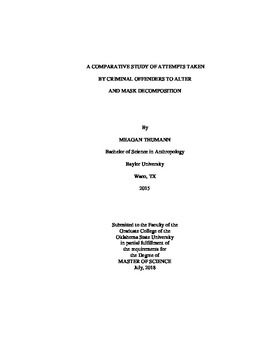| dc.contributor.advisor | Thrasher, Ronald R. | |
| dc.contributor.author | Thumann, Meagan | |
| dc.date.accessioned | 2019-03-20T19:09:58Z | |
| dc.date.available | 2019-03-20T19:09:58Z | |
| dc.date.issued | 2018-07-01 | |
| dc.identifier.uri | https://hdl.handle.net/11244/317620 | |
| dc.description.abstract | Within a few minutes of death, insects facilitate decomposition. The process of decomposition and insect life cycles become evidence to the criminal investigator. However, criminal offenders may try to alter or mask decomposition to prevent their crimes from being discovered. The use of chemicals is one common method a criminal offender may use to hide a crime. How these chemicals effect decomposition is not well known. Some chemicals reduce odors and prevent insects from locating the body; some chemicals repel insects outright. Changes in insect patterns can alter time of death estimations and therefore effect time of death estimations. | |
| dc.description.abstract | This research questioned forensic pathologists, forensic anthropologists, forensic archaeologists, and death scene investigators throughout Oklahoma to compile experience with criminal offenders attempting to alter and/or mask decomposition of crime victims. The questions focused particularly with the use of chemicals. Chemicals used and identified from a questionnaire included lye, bleach, and Febreze®. Other chemicals included N,N-Diethyl-meta-toluamide (DEET) insect repellent and a more natural remedy, Avon® Skin So Soft original body lotion because of its use as an insect repellent. I performed an experiment to test the effects of these chemicals on decomposition rates of animal cadavers; followed by a statistical analysis to determine significant differences between decomposition rates in the presence of chemicals. | |
| dc.description.abstract | Results showed that when comparing the data sets from both experiments, the chemicals applied to the animal cadavers showed no statistically significant differences in decomposition rates. I performed a one-way ANOVA of the differences in weights, a one-way ANOVA of the weight ratios, a type 3 tests of the fixed effects of time and chemical treatment, as well as looking at the simple effects of the treatments given time. All of the statistical analyses provided p-values above the p<0.05 level, indicating no significant differences. The only significant difference to decomposition rates reported was time. In conclusion, despite the efforts I made to alter or mask decomposition by applying different chemicals, none of them appeared to significantly impact decomposition. However, observations were documented suggesting differences in the way fur-bearing animals decompose compared to non-fur-bearing animals providing questions for additional research. | |
| dc.format | application/pdf | |
| dc.language | en_US | |
| dc.rights | Copyright is held by the author who has granted the Oklahoma State University Library the non-exclusive right to share this material in its institutional repository. Contact Digital Library Services at lib-dls@okstate.edu or 405-744-9161 for the permission policy on the use, reproduction or distribution of this material. | |
| dc.title | Comparative Study of Attempts Taken by Criminal Offenders to Alter and Mask Decomposition | |
| dc.contributor.committeeMember | Hess, James Daniel | |
| dc.contributor.committeeMember | Payton, Mark E. | |
| osu.filename | Thumann_okstate_0664M_15854.pdf | |
| osu.accesstype | Open Access | |
| dc.description.department | Forensic Sciences | |
| dc.type.genre | Thesis | |
| dc.type.material | text | |
